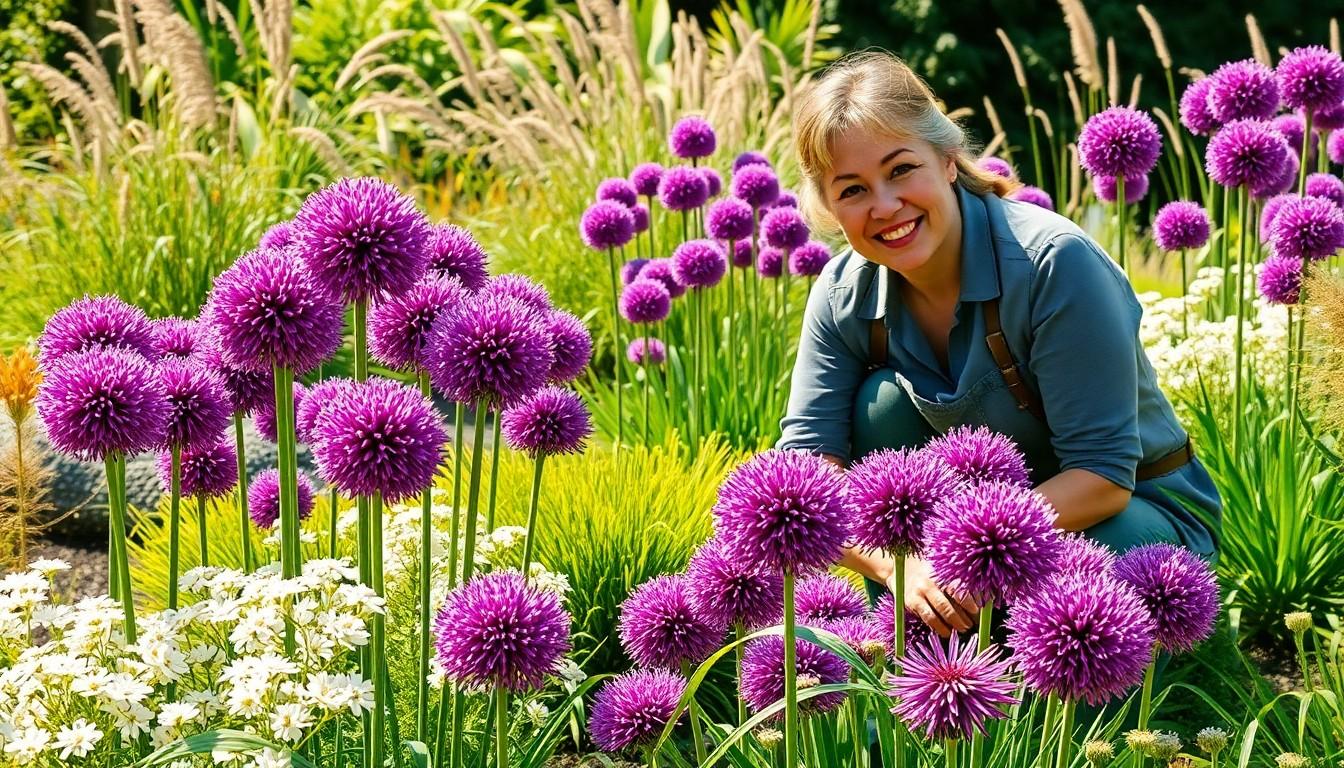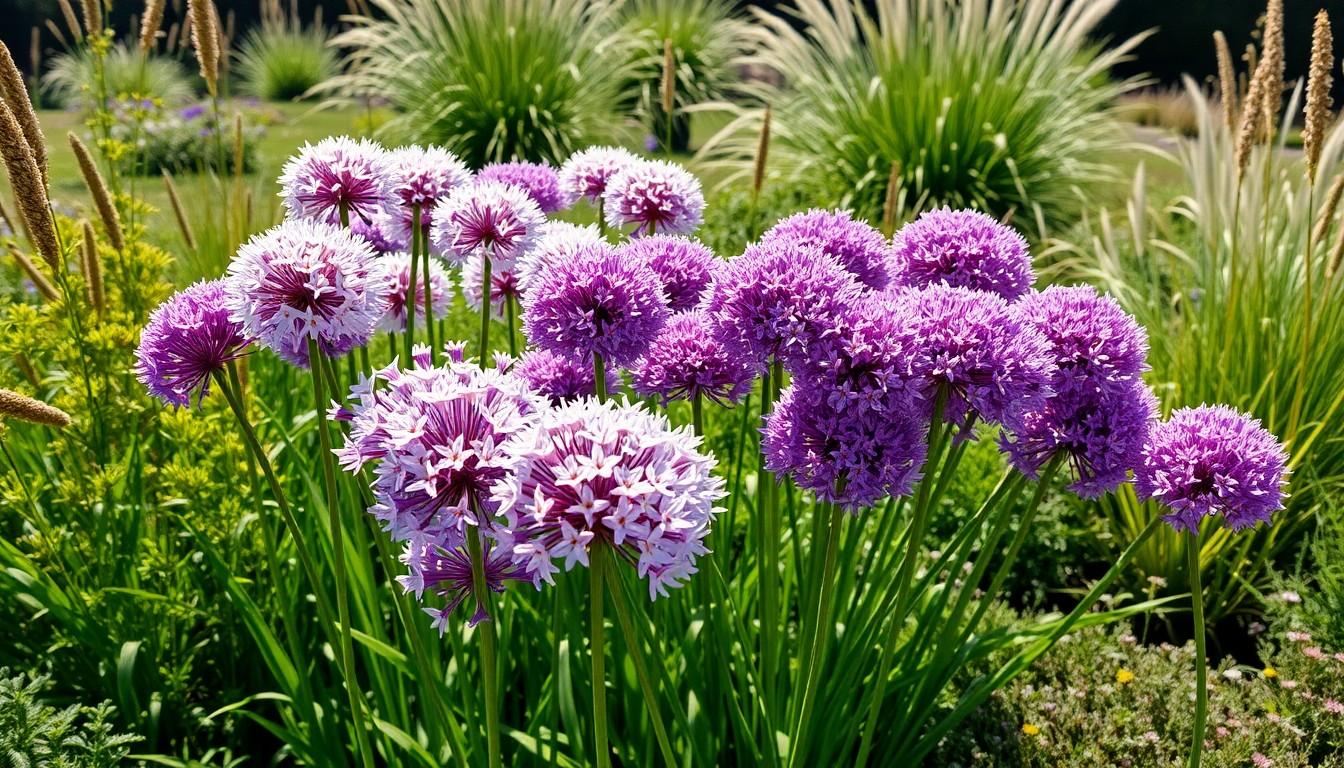The Best Fluffy Pancakes recipe you will fall in love with. Full of tips and tricks to help you make the best pancakes.

Allium Garden Design: Transform Your Outdoor Space with Stunning, Low-Maintenance Blooms
Imagine a garden that not only looks stunning but also makes your neighbors green with envy. Allium garden design is the secret weapon every aspiring gardener needs. With their striking spherical blooms and easy-going nature, alliums are like the divas of the flower world—showy yet low-maintenance.
Allium Garden Design
Allium garden design emphasizes the aesthetic appeal of Allium species, known for their spherical flowers that create a striking visual impact. These plants thrive in various garden settings, offering versatility for any landscape. Choosing different Allium varieties can result in a stunning color palette, ranging from subtle whites to deep purples.
Planting Alliums in groups enhances their dramatic effect, making them a focal point in flower beds. Combining Alliums with perennials and ornamental grasses can create beautiful layers and diverse textures. Each variety adds its unique height, allowing for a dynamic vertical garden structure.
Consideration of sun exposure and soil type is crucial in allium garden design. Full sun conditions maximize blooming potential, while well-drained soil prevents root rot. Integrating companion plants like lavender or echinacea works well, as they share similar care requirements and complement Allium blooms.
Maintenance remains simple, which resonates with busy gardeners. Watering during dry spells supports growth, but over-watering should be avoided. Deadheading spent flowers extends the blooming period and maintains garden aesthetics.
Incorporating Alliums into themed gardens or pollinator-friendly spaces encourages biodiversity. The unique flowering structure attracts bees and butterflies, benefiting the overall ecosystem.
Ultimately, Allium garden design provides both beauty and functionality, making it a preferred choice among garden enthusiasts. Building a garden with these plants ensures a vibrant and low-maintenance outdoor oasis.
Benefits Of Using Alliums In Gardens

Alliums offer numerous advantages for garden design, enhancing visual appeal while ensuring easy care. Their striking appearance and minimal upkeep make them a preferred choice for many gardeners.
Aesthetic Appeal
Alliums showcase beautiful, spherical blooms that draw attention in any garden. Various species present a versatile color palette, ranging from soft whites to rich purples. When planted in groups, alliums create a stunning focal point, elevating the overall landscape design. Combining these flowers with different perennials and ornamental grasses adds layers of texture and depth, resulting in a dynamic display. Seasonal changes highlight their unique forms and colors, ensuring visual interest throughout the growing season.
Low Maintenance Requirements
Alliums require minimal care, appealing to busy gardeners. Watering during dry spells is sufficient to keep them thriving. After blooming, simple deadheading can extend the display period and promote healthy growth. Resilient by nature, alliums adapt well to various soil types and sun exposure conditions. Their toughness also contributes to fewer pest problems and diseases, reducing the need for chemical treatments. Overall, incorporating alliums into garden design simplifies maintenance while enhancing beauty and biodiversity.
Popular Allium Varieties
Allium varieties add unique charm to any garden design. Choosing the right types can enhance visual appeal and biodiversity.
Giant Allium
Giant Allium, known as Allium giganteum, features impressive round clusters of purple flowers reaching heights of up to four feet. Mature blooms measure about six inches in diameter, creating a breathtaking sight in any landscape. This variety thrives in well-drained soil and full sunlight, making it ideal for sunny gardens. Their dramatic presence draws attention and adds elegance, particularly when planted in groups. In addition, they attract pollinators, contributing to a vibrant ecosystem. Being drought-tolerant, Giant Alliums require minimal watering once established, making them a perfect choice for low-maintenance gardens.
Drumstick Allium
Drumstick Allium, or Allium sphaerocephalon, showcases unique egg-shaped flower clusters that transition from green to deep red as they mature. Typically growing between two and three feet tall, these alliums blend well with various perennials and grasses. Their ability to adapt to different soils, including clay and sandy types, adds to their versatility in garden design. Blooms appear in late spring to early summer, extending seasonal interest. Drumstick Alliums also attract beneficial insects, boosting overall garden health. With minimal care requirements and striking visual appeal, they serve as an eye-catching addition to any garden.
Designing Your Allium Garden
Crafting an allium garden requires thoughtful planning and design. Emphasizing layout and spacing ensures optimal growth and visual impact.
Layout and Spacing
Spacing alliums properly enhances their stunning appearance. Space bulbs at least six to twelve inches apart for adequate airflow and growth. Clustering alliums in groups of three to five creates a unified look, making the blooms stand out. Positioning taller varieties, like Giant Allium, towards the back and shorter types, such as Drumstick Allium, in front establishes depth in flower beds. Incorporating this layout improves visibility from various angles, transforming any garden into an engaging visual experience.
Color Combinations
Implementing color combinations adds drama to an allium garden. Pair purple alliums with white perennials for a striking contrast. Using shades of pink alongside deep blues introduces harmony and vibrancy. Grouping alliums with ornamental grasses creates a stunning blend of textures and colors. This combination attracts pollinators while ensuring continuous blooms throughout the seasons. Carefully selecting complementary colors enhances overall design, elevating the garden’s appeal and creating a memorable outdoor space.
Maintenance Tips For Allium Gardens
Maintaining an allium garden requires simple actions that promote healthy growth and vibrant blooms. Focus on watering and fertilizing practices to ensure alliums thrive.
Watering and Fertilizing
Regular watering promotes allium health, especially during dry spells. Water should penetrate about six inches deep, and applying a layer of mulch can conserve moisture. Fertilizing with a balanced, slow-release product boosts growth. Spreading fertilizer in early spring before growth begins sets the stage for robust flowering. After blooms fade, stop fertilizing, allowing the plant energy to replenish itself for next season.
Pest Control
Pest control involves preventive measures that promote allium vitality. Regular inspections of plants reveal early signs of issues like aphids or onion flies. Removing damaged or affected foliage helps limit infestations. Natural remedies such as neem oil can fend off pests without harming beneficial insects. Encouraging beneficial insects, like ladybugs, to inhabit the garden further decreases pests. With these strategies, gardeners can maintain healthy allium blooms while minimizing pest-related challenges.
Allium garden design offers a unique blend of beauty and simplicity that appeals to both novice and experienced gardeners. With their stunning blooms and minimal care requirements, alliums stand out as a top choice for enhancing outdoor spaces. By thoughtfully planning their layout and combining different varieties, gardeners can create striking displays that attract pollinators and provide seasonal interest.
Incorporating alliums not only elevates the aesthetic of a garden but also contributes to its biodiversity. With the right maintenance practices, these resilient plants can thrive for years, making them a worthwhile investment for any garden enthusiast. Embracing alliums in garden design can transform an ordinary landscape into a vibrant oasis.
